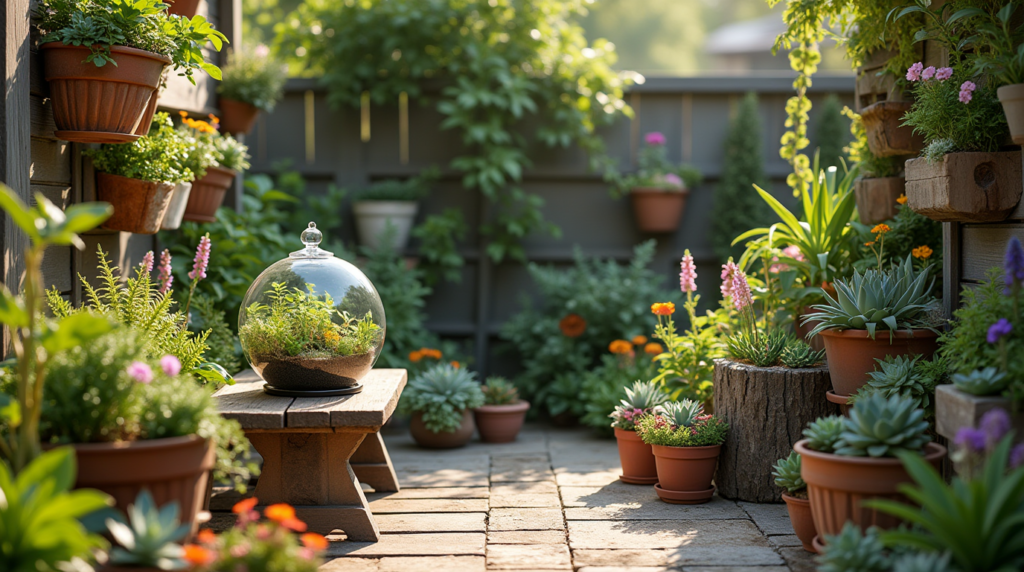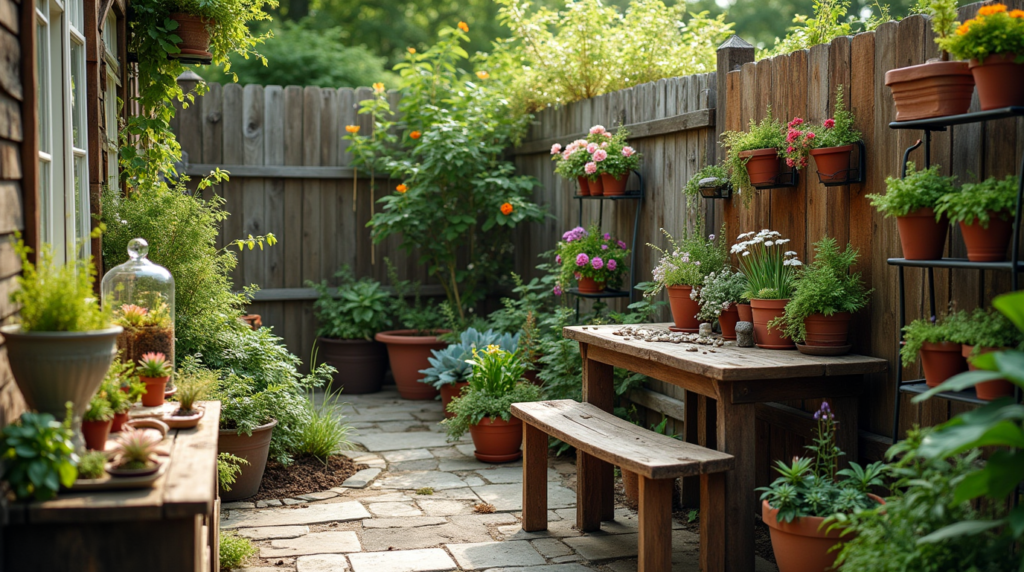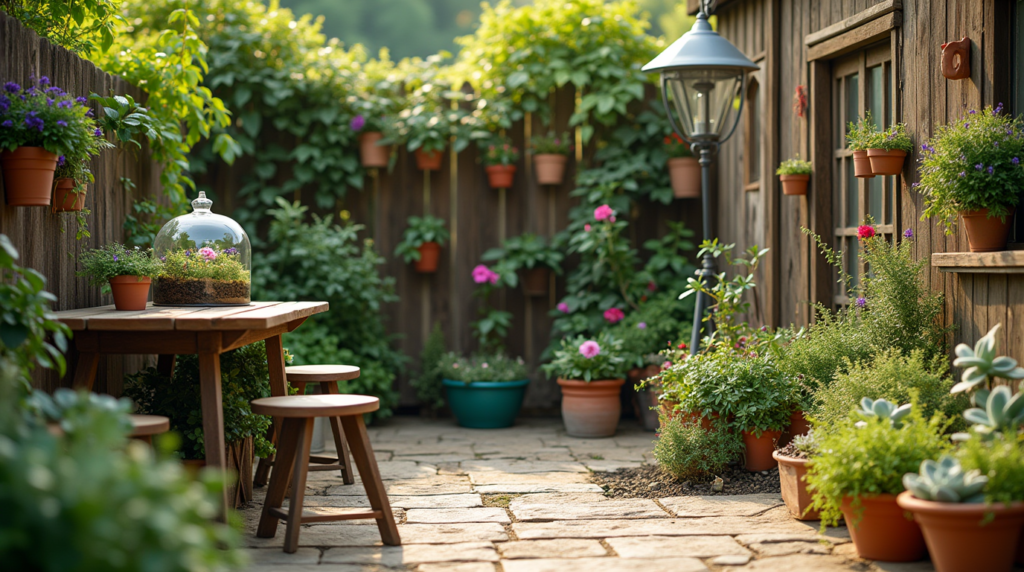Have you ever gazed longingly at beautiful garden photos, only to sigh and think, “If only I had more space”? I’ve been there too. Growing up in a small apartment in the city, I yearned for greenery but believed gardening was a luxury reserved for those with sprawling backyards. It wasn’t until I discovered the world of tiny gardens that I realized: size doesn’t limit creativity; it enhances it.
Tiny gardens aren’t just scaled-down versions of traditional gardens—they’re mindful, intentional spaces that prove you don’t need acres to cultivate beauty. Whether you have a modest balcony, a narrow windowsill, or just a neglected corner in your apartment, there’s a tiny garden concept waiting to transform that space into your personal oasis.
In this guide, I’ll share seven inspiring tiny garden ideas that have not only changed my living space but have become therapeutic retreats in my daily life. Let’s explore how thinking small can lead to big satisfaction in your gardening journey.
Table of Contents
Why Tiny Gardens Are Having a Moment
The Rise of Small-Space Living
Urban living continues to trend upward, with 56% of the world’s population now residing in cities. This shift has created a generation of nature-lovers confined to smaller living spaces. Tiny gardens have emerged as the perfect solution, allowing urbanites to reconnect with nature despite spatial limitations.
Benefits Beyond Beauty
Tiny garden cultivation offers more than just aesthetic appeal:
- Mental Health Improvement: Studies show that interacting with plants for just 20 minutes daily can reduce stress hormone levels
- Air Purification: Even small plant collections improve indoor air quality
- Sustainable Living: Compact gardens use fewer resources while still providing ecological benefits
- Accessibility: Require less physical exertion than traditional gardens, making gardening possible for those with mobility issues
| Tiny Garden Type | Space Required | Maintenance Level | Cost to Start |
|---|---|---|---|
| Terrarium | <1 sq ft | Very Low | $15-50 |
| Window Box | 2-4 sq ft | Medium | $20-75 |
| Vertical Garden | Wall space | Medium-High | $50-200+ |
| Fairy Garden | 1-2 sq ft | Low | $30-100 |
| Balcony Container Garden | 10-30 sq ft | Medium | $100-300 |
| Indoor Herb Garden | 1-3 sq ft | Medium | $25-75 |
| Succulent Arrangement | <1 sq ft | Very Low | $15-60 |
Now, let’s dive into our seven tiny garden inspirations that can transform even the smallest spaces.

1. Terrarium Magic: Worlds Under Glass
A Self-Contained Ecosystem
Terrariums offer a fascinating glimpse into miniature ecosystems. These glass-enclosed gardens create their own microclimate, often requiring minimal maintenance after initial setup.
How to Create Your Own Terrarium
- Choose the right container – Clear glass with or without a lid (closed terrariums need less watering)
- Add drainage layers – Start with pebbles, then activated charcoal to prevent mold
- Add soil suitable for your plants – Most terrariums thrive with well-draining potting mix
- Select appropriate plants – Small ferns, mosses, fittonias, and peperomias work well
- Decorate mindfully – Add tiny figurines, colored stones, or driftwood for personality
Plant Selection Tips
For closed terrariums, moisture-loving plants like ferns and mosses thrive. For open arrangements, succulents and air plants make excellent low-maintenance choices. Always choose slow-growing varieties to prevent overcrowding.
“A terrarium is like a tiny planet that you curate and care for. There’s something deeply satisfying about creating a whole world in a jar.” – Tovah Martin, author of “The New Terrarium”
2. Vertical Gardens: Growing Up Instead of Out
Maximizing Limited Floor Space
When horizontal space is scarce, the solution is simple: grow upward. Vertical gardens utilize walls, trellises, and hanging systems to create stunning green displays without consuming precious floor area.
DIY Vertical Garden Ideas
- Pocket planters – Fabric wall-mounted pockets perfect for herbs and small flowers
- Repurposed pallets – Painted and lined with landscape fabric for an industrial-chic look
- Shoe organizers – Plastic pockets can be filled with soil and plants for instant greenery
- Tiered plant stands – Multidimensional displays that create plant “towers”

Best Plants for Vertical Gardens
Look for:
- Trailing varieties (pothos, string of pearls)
- Compact growers (small ferns, succulents)
- Herbs (rosemary, thyme, basil)
- Small flowering plants (pansies, impatiens)
Vertical gardens work particularly well for herbs, creating accessible kitchen gardens that double as living decor. They’re perfect for balconies, fence sides, and even indoor wall spaces with adequate lighting.
3. Container Gardens: Portable Perfection
Flexibility for Changing Needs
Container gardens offer unparalleled flexibility—they can be moved to follow sunlight, rearranged for seasonal appeal, or completely redesigned on a whim.
Container Selection Strategy
Materials to consider:
- Terracotta (breathable but heavy)
- Ceramic (decorative but can be fragile)
- Plastic (lightweight and affordable)
- Metal (modern aesthetic but can heat up)
- Fabric pots (excellent drainage and air pruning)
Design Principles for Tiny Container Gardens
Follow the “thriller, filler, spiller” approach:
- Thriller: A tall, dramatic centerpiece plant
- Filler: Mid-height plants that add volume
- Spiller: Trailing plants that cascade over edges
![Container garden with thriller, filler, spiller arrangement]
Creative Container Ideas
Think beyond traditional pots:
- Vintage teacups for succulents
- Old boots for flowering plants
- Colanders for herbs (built-in drainage!)
- Hollowed logs for woodland plants
- Tin cans painted in bright colors
4. Window Box Wonders: Gardens on Display
Showcasing Seasonal Beauty
Window boxes instantly enhance curb appeal while allowing you to enjoy their beauty both from inside and outside your home.
Construction Considerations
- Ensure proper mounting and weight support
- Install proper drainage holes
- Choose weather-appropriate materials (cedar, vinyl, or fiberglass)
- Consider self-watering designs for easier maintenance
Seasonal Planning Guide
| Season | Recommended Plants | Color Schemes |
|---|---|---|
| Spring | Pansies, tulips, daffodils | Pastels and bright yellows |
| Summer | Petunias, geraniums, verbena | Bold reds, purples, and pinks |
| Fall | Ornamental cabbage, mums | Oranges, reds, and bronze |
| Winter | Evergreen branches, berries | Greens with red accents |
Design Tips for Maximum Impact
- Plant taller varieties toward the back
- Create depth with cascading plants at the front
- Choose a consistent color theme (monochromatic or complementary colors)
- Consider adding solar-powered fairy lights for evening ambiance
5. Fairy Gardens: Miniature Whimsy
Creating Tiny Magical Worlds
Fairy gardens combine horticulture with dollhouse-like creativity, resulting in enchanting miniature landscapes that delight both children and adults.
Essential Elements of a Fairy Garden
- Pathways made from pebbles, broken pottery, or miniature bricks
- Tiny structures like houses, bridges, or gazebos
- Appropriately scaled plants such as mini ferns, wooly thyme, or baby’s tears
- Personal touches that tell a story or reflect your personality
Plant Selection for Scale
Choose naturally small or slow-growing varieties:
- Irish moss
- Miniature African violets
- Dwarf varieties of common plants
- Baby tears (Soleirolia soleirolii)
- Creeping thyme
Interactive Elements
Consider adding:
- Tiny swing sets or seesaws
- Miniature water features
- Battery-operated tiny lights
- Seasonal decorations that can be changed
Fairy gardens are particularly wonderful projects to create with children, sparking imagination while teaching plant care basics.
6. Office Desktop Gardens: Productivity Boosters
Bringing Nature to Your Workspace
Research shows that having plants in your workspace can increase productivity by up to 15% while reducing stress and sick days.
Low-Maintenance Office-Friendly Plants
- ZZ Plants – Tolerate low light and infrequent watering
- Snake Plants – Air purifying and nearly indestructible
- Pothos – Trailing vines that thrive in office conditions
- Air Plants – No soil needed, just occasional misting
- Small Succulents – Require minimal attention
Creative Workspace Garden Ideas
- Magnetic planters attached to filing cabinets
- Monitor surround gardens utilizing the space around your screen
- Desk drawer herb garden with grow lights for fresh tea ingredients
- Keyboard gap planters in custom-fit containers
- Pencil holder hybrid planters combining function and greenery
Benefits for Work Performance
Desktop gardens offer more than decoration—they provide:
- Visual breaks that reduce eye strain
- Improved air quality in often-stale office environments
- Natural stress reduction through connection with nature
- Conversation starters with colleagues
- Opportunities for mindful moments during busy days
7. Succulent Arrangements: Art You Rarely Water
Nature’s Living Sculptures
Succulent arrangements combine striking architectural forms with incredibly low maintenance requirements, making them perfect for busy people or those new to plant care.
Creating Eye-Catching Arrangements
- Choose a shallow, wide container with drainage
- Use proper succulent/cactus soil for drainage
- Arrange plants while still in nursery pots to perfect placement
- Consider height, texture, and color variations for visual interest
- Add decorative top dressing like colored sand or small pebbles
Unique Display Ideas
- Living walls in shadow box frames
- Vintage book planters with hollowed-out pages
- Teacup clusters grouped on tiered stands
- Driftwood mounted arrangements that appear to float
- Geometric glass containers for modern aesthetics
Propagation: The Gift That Keeps Giving
One of the joys of succulents is how easily they propagate:
- Many varieties grow new plants from single leaves
- Cuttings often root readily in soil or water
- This allows you to expand your garden or share plants with friends
Maintaining Your Tiny Garden: Essential Care Tips
Watering Wisdom
Overwatering kills more tiny garden plants than underwatering. For most arrangements:
- Let the top inch of soil dry out before watering again
- Water less frequently in winter when growth slows
- Use a spray bottle for terrariums and delicate arrangements
- Consider self-watering systems for consistent moisture
Light Requirements
Different tiny gardens need different light levels:
- Bright direct light: Most succulents and cacti
- Bright indirect light: Tropical terrariums and many flowering plants
- Medium light: Ferns, mosses, and many foliage plants
- Low light: ZZ plants, snake plants, pothos
Monitor your plants for signs of too much light (fading, brown spots) or too little (leggy growth, pale leaves).

Seasonal Care Adjustments
As seasons change, so should your care routine:
- Reduce water in winter months
- Move containers away from drafts or heat sources
- Consider supplemental lighting during dark winter days
- Adjust fertilizing schedule (more in growing season, none in winter)
Conclusion: Your Tiny Garden Journey
The beauty of tiny gardens lies not just in their size but in their ability to connect us with nature regardless of our living situation. They remind us that gardening isn’t about sprawling spaces but about the care and creativity we invest.
Whether you choose a magical terrarium, a productive herb container, or a whimsical fairy garden, you’re creating more than just a display—you’re cultivating a living connection to the natural world and carving out a moment of peace in your daily life.
Start small, experiment often, and remember that even the tiniest garden can yield enormous joy. Your perfect tiny garden is just a container away.
FAQ About Tiny Gardens Inspiration
What are the easiest plants for beginners to use in tiny gardens?
Succulents, pothos, snake plants, and ZZ plants are among the most forgiving options for tiny garden beginners. They require minimal care and can survive occasional neglect, making them perfect for those just starting their tiny garden inspiration journey.
How often should I water my tiny garden?
It depends on the type of tiny garden. Terrariums might need watering only once a month, while small container gardens might need water weekly. Always check the top inch of soil—if it’s dry, it’s time to water. Most tiny garden plants suffer more from overwatering than underwatering.
Can tiny gardens attract pests indoors?
While any plants can potentially attract pests, tiny gardens are generally manageable. Prevent issues by avoiding overwatering, ensuring good air circulation, and occasionally wiping leaves. Natural solutions like neem oil can address most common pests without harsh chemicals.
How can I create a tiny garden if I have pets?
Many popular tiny garden plants can be toxic to pets. Focus on pet-safe options like spider plants, Boston ferns, areca palms, and certain herbs. Alternatively, create enclosed terrariums or place tiny gardens in areas inaccessible to curious pets.
What’s the best tiny garden inspiration for someone with absolutely no outdoor space?
Terrariums, small desktop arrangements, and windowsill herb gardens are perfect for those without any outdoor access. These tiny garden ideas require minimal space and can thrive entirely indoors with proper light conditions.
